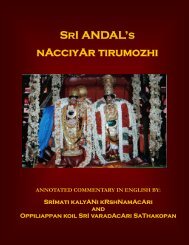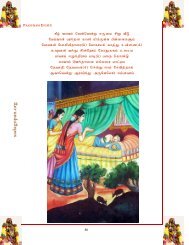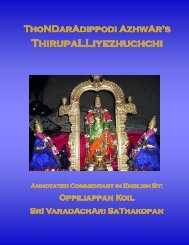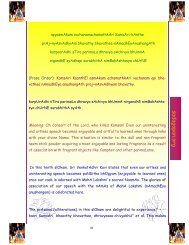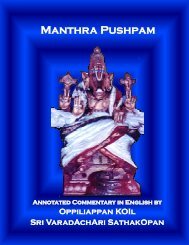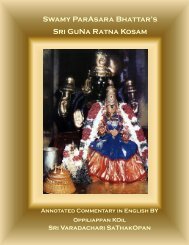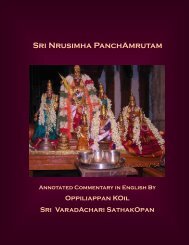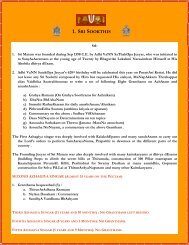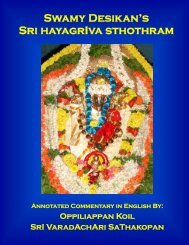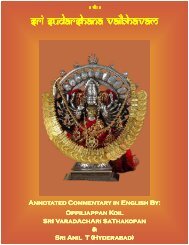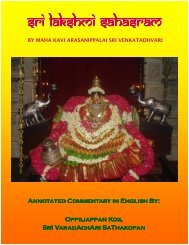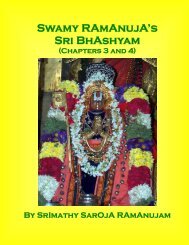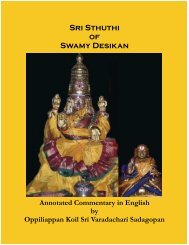Sri Sthavam.pub - Sundarasimham
Sri Sthavam.pub - Sundarasimham
Sri Sthavam.pub - Sundarasimham
You also want an ePaper? Increase the reach of your titles
YUMPU automatically turns print PDFs into web optimized ePapers that Google loves.
Swamy Kuresar’s<br />
<strong>Sri</strong> <strong>Sthavam</strong><br />
Oppiliappan KOil<br />
<strong>Sri</strong> VaradAchAri SaThakOpan<br />
&<br />
<strong>Sri</strong> V. MAdhavakaNNan
sadagopan.org
1<br />
2<br />
3<br />
4<br />
5<br />
6<br />
7<br />
8<br />
9<br />
10<br />
11<br />
12<br />
13<br />
14<br />
CONTENTS<br />
Introduction 1<br />
Taniyan 3<br />
SlOkams and Commentary 3<br />
SlOkam 1 6<br />
SlOkam 2 9<br />
SlOkam 3 11<br />
SlOkam 4 12<br />
SlOkam 5 13<br />
SlOkam 6 14<br />
SlOkam 7 15<br />
SlOkam 8 16<br />
SlOkam 9 & 10 17<br />
SlOkam 11 19<br />
Nigamanam 21<br />
sadagopan.org
sadagopan.org
INTRODUCTION:<br />
. ïI>.<br />
. ïIStv> .<br />
SRI STHAVAM<br />
Swamy KurEsar<br />
Swamy KurEsar (KuratthAzhwAn) is from the village of Kooram, which is not far from Lord<br />
VaradarAjan’s temple at Kaanchipuram. He was a wealthy person, who gave a lot to charity.<br />
His wife (ANDAL) was a great soul, who supported her husband’s philanthropy with zest as an<br />
ideal Saha-dharmachAriNi.<br />
Swamy KurEsar is also known as <strong>Sri</strong>vatsAnkamisra. He lived from 1010-1116 CE. He was a very<br />
important SishyA of AchArya RaamAnuja (1017-1137 C.E). KurEsar was thus 7years senior to<br />
AchArya RaamAnuja and ascended to Parama Padham some 21 years before his AchAryan.<br />
KurEsar assisted AchArya RaamAnuja in the writing of <strong>Sri</strong> BhAshyam. The Five devotional<br />
lyrics (AthimAnusha <strong>Sthavam</strong>, VaradarAja <strong>Sthavam</strong>, SrI <strong>Sthavam</strong>, SundarabAhu <strong>Sthavam</strong> and<br />
<strong>Sri</strong> Vaikunta <strong>Sthavam</strong>) were bequeathed to us by Swamy KurEsar. These <strong>Sthavam</strong>s are the path<br />
breakers for exemplary devotional lyrics as well as rich resources for understanding of the<br />
esoteric <strong>Sri</strong> VaishNavite Tatthvams. Swamy ParAsara Bhattar, the precocious son of KurEsar<br />
and Swamy Desikan traveled on the road laid out by KurEsar in composition of the devotional<br />
lyrics (SthOtrams) and enriched <strong>Sri</strong> VaishNavite Literature further.<br />
1<br />
sadagopan.org
sadagopan.org<br />
It is adiyEn’s bhAgyam to venture into posting article on the mighty Pancha <strong>Sthavam</strong>s of<br />
KurEsar and seek His anugraham to undertake this task. Fortunately another <strong>Sri</strong>vatsAnkAchAr<br />
Swamy, contemporary SCholar of extraordinary sCholarship has blessed us with MaNipravALa<br />
commentary on these five <strong>Sthavam</strong>s (1986-88 CE). U. Ve. MahA VidwAn, U.Ve. PaiyampADi<br />
CheEtlUr <strong>Sri</strong> <strong>Sri</strong>vathsAnkAchAr Swamy is the illustrious disciple of Abhinava Desika, U.Ve. <strong>Sri</strong><br />
UtthamUr VeerarAghavAchArya Swamy. adiyEn will closely follow the commentary of U.Ve.<br />
<strong>Sri</strong> SrIvathsAnkAchAr Swamy.<br />
At the outset, adiyEn prostrates before asmath AchAryan, HH <strong>Sri</strong> VaNN SathakOpa, <strong>Sri</strong><br />
NaarAyaNa YathIndhra MahA Desikan, the prakrutham <strong>Sri</strong>math Azhagiya Singar and seeks<br />
His anugraham to undertake this difficult task.<br />
THE FIVE STHAVAMS OF KURESAR (NADAMADUM PATANJALI)<br />
1. <strong>Sri</strong> <strong>Sthavam</strong> has 11 slOkams on the Parama Paavana, Dayaa Moorthy, SrI <strong>Sri</strong>ranga<br />
NaacchiyAr. This sthavam is a moving eulogy of the divine consort of Lord<br />
RanganAtha.<br />
2. <strong>Sri</strong> Vaikunta <strong>Sthavam</strong> has 100 slOkams. The old proverb is: The one who does not<br />
know <strong>Sri</strong> Vaikunta <strong>Sthavam</strong> is not a VaishNavan. This is the Saaram of <strong>Sri</strong> Bhaashyam<br />
and focuses on Parama Padha Naathan.<br />
3. AthimAnusha <strong>Sthavam</strong> containing 61 slOkams. This deals with the AthimAnusha<br />
dhivya ChEsthithams of RaamA and KrishNa, who took the form of Manushyan<br />
(Human Being) in their Vibhava avathArams and moved among us and performed the<br />
extraordinary, divine deeds.<br />
4. <strong>Sri</strong> Sundara Baahu <strong>Sthavam</strong> is about ThirumAlirum ChOlai KaLLazhagar (<strong>Sri</strong> Sundara<br />
Baahu PeumaL). This Sthvam has 132 slOkams. KurEsar's family moved to the village<br />
of Kuram after generations of Kaimkaryam to Sundara Baahu PerumAL at<br />
ThirumAlirumchOlai dear to ANDAL and PeriyAzhwAr. That is why, Swamy KurEsar<br />
has a special attachment to <strong>Sri</strong> Sundara Baahu of ThirumAlirum ChOlai.<br />
5. <strong>Sri</strong> VaradarAja <strong>Sthavam</strong> is about Kaanchi Varadhar. It has 102 slOkams and is very<br />
dear to Swamy Desikan, who was inspired to compose SrI VaradarAja PanchAsath.<br />
The VaradarAja <strong>Sthavam</strong> is the last of the Pancha <strong>Sthavam</strong>s composed by Haareetha<br />
Kula Tilakam. Swamy KurEsar composed it in front of Lord VaradarAjan as<br />
commanded by his AchAryan to gain back the eyesight that he lost from the atrocity<br />
committed by the cruel ChOLA King. In this <strong>Sthavam</strong>, KurEsar prayed for the<br />
Moksham of NaalUrAn, the sishyan who became a drOhi to him (his own AchAryan).<br />
Such is the greatness of Swamy KurEsar.<br />
2
TANIYAN<br />
Let us start with the recitation of the Taniyan of KurEsar!<br />
MEANING:<br />
ïIvTsicûimïe_yae nm %i´mxImhe ,<br />
yÊKtyôyIk{Qe yaiNt m¼¦ sUÇtam! .<br />
<strong>Sri</strong>vatsachihnamisrEbhyO nama ukthim adhImahE |<br />
YaduktayastrayIkantE yaanthi MangaLa sutratAm ||<br />
KooratthAzvAn’s <strong>Sri</strong> Sookthis (sacred utterances) have attained the state of ThirumAngalyam<br />
(auspicious thread worn by Sumangalis) around the neck of Veda MaathA. We recite the word<br />
of Nama: for the MahA PaNdithar, KurEsar with the same reverence as we recite the sacred<br />
Veda manthrams (nama ukthim adheemahE).<br />
SLOKAMS AND COMMENTARY<br />
Back in February of 1996 (Feb10 and 14), adiyEn posted 5 articles on <strong>Sri</strong> <strong>Sthavam</strong> following the<br />
Tattva Chintamani Vyakyaanam of U.Ve. Vaikunta Vaasi, <strong>Sri</strong> PrathivAdhi Bhayankaram<br />
AnnangarAcchAr (PBA) Swamy of Kancheepuram <strong>pub</strong>lished in 1947. These articles can be<br />
accessed through Acharyans section in www.Sadagopan.org.<br />
adiyEn is expanding the commentaries with additional insights from U.Ve.PaiyampADi<br />
CheEtlUr <strong>Sri</strong> <strong>Sri</strong>vathsAnkAchAr Swamy’s 1986 commentary. Together, this extended coverage<br />
on <strong>Sri</strong> Devi lauded as “MangaLAnAm MangaLam” by Swamy Desikan will bless us with<br />
Bhakthi for Her.<br />
adiyEn will integrate the two commentaries on the individual verses of <strong>Sri</strong> <strong>Sthavam</strong> of KurEsar.<br />
The trendsetters for the VaishNavite AchArya’s SthOthrams on <strong>Sri</strong> Devi are:<br />
1. SrISooktham from the Vedam<br />
2. Swamy AlavanthAr’s ChathusslOki before KurEsar’s time and afterwards<br />
3. Swamy ParAsara Bhattar’s <strong>Sri</strong> GuNaratna Kosam (e-book on<br />
www.sundarasimham.org)<br />
4. <strong>Sri</strong> Sthuthi of Swamy NigamAntha MahA Desikan (e-book on<br />
www.sundarasimham.org)<br />
5. His son’s, KumAra VaradhAryA’s Lakshmi Sathakam in MandhAkrAntha meter<br />
6. <strong>Sri</strong> Chakravarthee AathrEya VenkatAdhvari’s <strong>Sri</strong> Laskhmi Sahasram<br />
7. <strong>Sri</strong> Thirukkudanthai Desikan’s KOmaLA DhaNdakam<br />
3<br />
sadagopan.org
sadagopan.org<br />
Regarding the power of Swamy AlavanthAr’s, ChathusslOki it has been said that one will<br />
become a PaNDithan (great learned one) through the understanding of the Tatthvams housed<br />
in ChathusslOki (Chathu: slOkEna PaNDitha:). It is no wonder that Swamy PeriyavAcchAn<br />
PiLLai and Swamy Desikan have written their commentaries on ChathusslOki after KurEsar’s<br />
time. It is also no surprise to <strong>Sri</strong> VaishNavAs that KurEsar should be inspired to start His<br />
Pancha <strong>Sthavam</strong> with <strong>Sri</strong> <strong>Sthavam</strong>.<br />
Many AchAryAs of recent times have also established the unique position of MahA Lakshmi in<br />
<strong>Sri</strong> SampradhAyam (Vibhuthva Paksha SthApanam) based on their PoorvAchArya Sookthis:<br />
1. <strong>Sri</strong> Lakshmi UpAyathva NirNaya: by <strong>Sri</strong> <strong>Sri</strong>nivAsa ParakAla MahA Desikan<br />
2. <strong>Sri</strong> Vibhuthva SamarTanam by AathrEya VenkatAdhvari<br />
3. <strong>Sri</strong> Lakshmi Sahasra Rathna PrakAsikaa by <strong>Sri</strong> KrishNa Brahma tantra ParakAla<br />
Swamy<br />
4. DhAsa DhAsi SamarTanam by HH 37th Pattam <strong>Sri</strong>math Azhagiya Singar in His <strong>Sri</strong><br />
Sookthi Vaadha TarangiNi<br />
Among all these SrI Sookthis on SrI Devi, Swamy AlavanthAr’s Chathu:slOki is saluted as<br />
“Maarga PradarshikA”, the Revealer of the auspicious path of <strong>Sri</strong> Tatthvam and Her<br />
yEkasEshithvam. Swamy KurEsar’s <strong>Sri</strong> <strong>Sthavam</strong> is next in that chronological order.<br />
There are 11 slOkams in <strong>Sri</strong> <strong>Sthavam</strong> of KurEsa. The first five are called Sthotropodhgaatam or<br />
introductory verses that express the author’s disqualifications to engage in praising the most<br />
auspicious <strong>Sri</strong> Devi. Here KurEsa states that he is acutely aware of his limitations as a poet to<br />
undertake such an impossible task. From verse 6, the actual stotram begins (Stotraarambham).<br />
The ninth and the tenth verses are in the form of his Prapatti at Her Lotus feet. The eleventh<br />
and the final verse of this <strong>Sthavam</strong> is a prayer to Her to cast Her benevolent glances on him<br />
and protect him and us as the prapannas seeking refuge in Her.<br />
The <strong>Sthavam</strong> begins with a Svasthi Vacahanam and PrArTanai (prayer) for <strong>Sri</strong> Devi to confer<br />
auspiciousness to all the worlds and their beings: (asesha jagatAm Svasthi SrI: disathAdh) and<br />
KurEsa prays for her blessings of Vaak Samrutti and Bhakti Samrutti (Abundance of poetic<br />
skills and wealth of Bhakthi) during the composition of the sthavam on Her.<br />
4
P.B. AnnangarAcchAr Swamy has constructed the following imaginary dialog between Maha<br />
Lakshmi and the supplicant, KurEsa: The dialog between <strong>Sri</strong> Devi and KurEsar as visualized<br />
by <strong>Sri</strong> PBA Swamy is one of the most moving.<br />
KurEsa: Svasthi Sreer DisathAdh (<strong>Sri</strong> Devi! May thou bless me)<br />
<strong>Sri</strong> Devi: My Child! You asked me to bless you with auspiciousness. What would you like?<br />
Abundant fame or wealth or progeny or all the three?<br />
KurEsa: O, Mother Divine! I do not want the perishable wealth or progeny or Fame. I am<br />
standing before you to praise your auspicious qualities to my heart’s content.<br />
<strong>Sri</strong> Devi: KurEsa! You are a great poet. You can go ahead anyway. What kind of Svasthi needs<br />
to be conferred as a boon by me beyond that?<br />
KurEsa: O, My Compassionate Mother! You should not take this attitude. You should bless me<br />
with adequate Saraswati Samrutti to undertake this task, which is currently beyond my ability,<br />
given the nature of the loftiness of the subject matter of my sthavam.<br />
<strong>Sri</strong> Devi: KurEsa! You already have been blessed with that gift. Please ask me for something<br />
else your heart desires.<br />
KurEsa: Mother! It is true that my tongue utters some words skillfully. I do not however have<br />
the mellowness and Bhakti to inform my intellect to engage in this holy task. Please give me<br />
that type of Jnanam.<br />
<strong>Sri</strong> Devi: KurEsa, My dear child! When you wished to offer eulogy to me, you obtained then<br />
and there such a Jnanam. If you did not have that Vaatsalyam and a heart steeped in devotion,<br />
you would not progress in your efforts. Therefore, Please ask me for some other boons that<br />
interests you.<br />
KurEsa: Oh, Supreme Mother! Your blessings have indeed given me a small measure of Bhakti<br />
for You. Please bless me further that it grows into Para Bhakti, Para Jnanam and Parama<br />
Bhakti as experienced by the Mudhal Aazhwaars at Thirukkovalur.<br />
<strong>Sri</strong> Devi: Kuratthaazhwaan! You do not need to worry over this. Those three that you desire will<br />
grow gradually (KrameNa) as in the case of the three Azhwaars. Why do you wish to ask for<br />
some thing that is going to grow anyway?<br />
KurEsa: O, Most Merciful Mother! I cannot bear to wait for a long time to experience my<br />
Bhakti grows through its different stages to become Parama Bhakti. I do not have the strength<br />
to go through that waiting period. Please bless me as I stand before You and make me Your<br />
servant (Kinkaran) and receive in return my most humble services. May Your merciful glances<br />
fall on me and uplift me! That is ALL I wish to ask as the supreme boon from You!<br />
<strong>Sri</strong> Devi: Azhwaan! You are so Blessed! I have granted you that boon. Thus begins the <strong>Sri</strong><br />
<strong>Sthavam</strong>.<br />
5<br />
sadagopan.org
sadagopan.org<br />
SLOKAM 1<br />
adiyEn will use the Anvaya Kramam (the prose order of this slOkam) to help appreciate the<br />
flow of <strong>Sri</strong> KurEsa’s thought<br />
AsEsha JagathAm Sarga Upasarga sTithee: Svargam durgathim aapavargika Padam<br />
Sarvam cha kurvan Hari: yasyA: Mukham veekshaya tadh ingitha parAdheena: akhilam<br />
vidhatthE: anyaTa asya thayA EikarsyaAth iyam asya rasadha na syAth kalu (saa) SrI<br />
Svasti DhisathAdh<br />
The first slOkam takes this form:<br />
SviSt ïIidRztadze;jgta< sgaeRpsgRiSwtI><br />
Svg¡ ÊgRitmapvigRkpd< svRÁc k…vRn! hir> ,<br />
ySya vIúy muo< tidi¼tpraxInae ivxÄe=iol<<br />
³Ifey< olu naNywa=Sy rsda SyadEkrSyaÄya .<br />
Svasthi SrIr-disathAdh asEsha-jagathAm sargOpasargasTithee:<br />
svargam dhurgathim Aapavargakika padham sarvam cha kurvan Hari: |<br />
YasyA Veekshya mukham tadhingitha-parAdhInO-vidhatthE akhilam<br />
kreeDEyam khalu nAnyaTAasya rasadA syadaikarasyAth tayA || (1)<br />
<strong>Sri</strong> RanganAyaki<br />
6
BhagavAn SrI Hari NaaraAyan�an takes His cues in the matters of Creation (Sarga:),<br />
Dissolution (Upasarga:), Protection (sTithee:), by seeking concurrence from the expressions in<br />
the beautiful face of His Consort. The world of DevAs (Svargam), Narakam (Dhurgathi), <strong>Sri</strong><br />
Vaikuntam/Moksha sTAnam (Aapavargika padham) and all other worlds are under His sway<br />
and He rules over them (Sarvam cha kurvan Hari:).<br />
He executes all these tasks by taking the directions/cues from the hints (ingitham) originating<br />
from SrI Devi’s auspicious face (Thirumukha MaNDalam). He is thus under Her total<br />
influence, and performs His work according to Her wishes. If this were not so, the BhagavAn<br />
will not enjoy the jagath srushti-rakshanNa-samhAra vyApArams.<br />
He is <strong>Sri</strong> Devi ParAdheenan, since He wants to please Her. He looks at Her face for the<br />
different signals and completes every thing according to Her wish (YasyA: Mukham Veekshya,<br />
tadhingitha ParAdheena: akhilam vidhatthE). He is thus under Her total control in these<br />
matters and goes about executing His work according to Her wishes. If this were not to be so,<br />
the Lord will not enjoy His Jagath Srushti-rakshaNa -SamhAra vyApArams. They are of unified<br />
mind and for their play, they delight in engaging in this chess game. They are yEka Seshi<br />
Dampathis. If there is no matching enjoyment (Eikarasyam), then this play of Creation et al<br />
won’t produce any joy for them (anyathA Asya tayA EikarasyAth iyam kreeDA rasathA na<br />
syAth khalu?). May SrI Devi of such power and who is united with Him at all times, places and<br />
states (Eikarasyam) confer auspiciousness on me to undertake this onerous task (asEsha<br />
JagathAm SrI: Svasthi disatAdh).<br />
<strong>Sri</strong> VathsAnkAcchAr Swamy points out that this prayerful request is modeled after the<br />
Vaakyam of Sage ParAsarA in <strong>Sri</strong> VishNu pUrANam: “Sa disathu BhagavAn asEshapumsAm<br />
Harirapajanma-jarAdhikam samruddhim”. Here, the father of Sage VyAsA who gave us the<br />
most sacred Saathvika PurANam (VishNu PurANam) prays for all jeevans to be blessed with<br />
every kind of MangaLam.<br />
The prayOgam of “Khalu” in this slOkam by KurEsar according to <strong>Sri</strong> <strong>Sri</strong>vathsAnkAchAr<br />
Swamy is to indicate that this yEka sEshithvam and Eikarasyam among them is celebrated in<br />
Veda -VedAnthams.<br />
The Eikarasyam concept is an important theme of Azhwaars. This is why RaamAnuja chose<br />
the Panguni Uttaram day to offer his SaraNAgati to the Divine couple, when he saw them<br />
physically seated together (Ekapeetam) on that day at <strong>Sri</strong>rangam temple. Swamy Desikan has<br />
dwelled on this concept in his works; has gone further to underline the related concept of<br />
EKASESHITVAM as one of the central principles of <strong>Sri</strong> VaishNavam as taught by his<br />
Poorvaacharyas. He salutes that extraordinary state of Interdependence of the divine couple in<br />
one of his slOkas of <strong>Sri</strong> Sthuti as follows:<br />
“Vishnu: tvam cha iti Dwandhvam anyOnya Lakshyam”. Oh! <strong>Sri</strong> Devi, You and your husband<br />
are bound forever by your love for each other. You are never far away from each other even for<br />
a moment; both of You with Your limitless, illustrious qualities are a PAIR that can be<br />
7<br />
sadagopan.org
sadagopan.org<br />
understood COMPLETELY ONLY through each other. That is why You are introduced as<br />
Vishnu Patni and he is known as <strong>Sri</strong>ya:Pathi. That is your extraordinary state of<br />
Interdependence.<br />
Thirukkudanthai KOmaLavalli<br />
8
SLOKAM 2<br />
he ïIdeRiv smSt laekjnnI— Tva< StaetumIhamhe<br />
yuKta< Éavy ÉartI< àgu[y àemàxana< ixym! ,<br />
Éi´< ÉNdy nNdyaiïtimm< das< jn< tavk<<br />
lúy< liúm kqa]vIicivs&te> te Syam camI vym! .<br />
hE SrIrdEvi! Samastha lOkajananeem thvAm stOthumeehAmahE<br />
yukthAm bhAvaya Bharatheem praguNaya prEmapradhAnam dhiyam |<br />
bhakthim bhandhaya nandayAsrithamimam dhAsam janam thaavakam<br />
lakshyam Lakshmi! KaDAkshaveechisruthE: tE syAma chAmee vayam || (2)<br />
Melkote Yadugiri NaachiyAr<br />
Oh Maha Lakshmi! You are the mother of the entire universe and its inhabitants. I wish to offer<br />
my praise to You. Please grant me the gift of Vak (Speech) appropriate for this task! Please<br />
grow my intellect and devotion to carry out this undertaking! May my Bhakti become Parama<br />
9<br />
sadagopan.org
sadagopan.org<br />
Bhakti through Your blessing! Please accept my Kaimkaryam as that coming from one, who<br />
has surrendered at Your Lotus feet. Please make me joyous through the acceptance of my<br />
Vaachika Kaimkaryam! May we the Prapannas become the object of the waves of Your most<br />
merciful and compassionate glances! This is the verse for which <strong>Sri</strong> P.B. Anna offered the<br />
imaginary dialog referred to above.<br />
KurEsar addresses MahA Lakshmi as “Samastha Loka Janani”and prays: “amee vayam cha tE<br />
katAksha veechi visruthE: lakshyam syAma”. Prayer here is for the people of the land (amee)<br />
and for those, who belong to the Thondar Kulam (vayam). AzhwAr prays for the waves of SrI<br />
Devi’s glances to fall on all.<br />
Thiru Anbil ThAyAr<br />
10
SLOKAM 3<br />
StaeÇ< nam ikmamniNt kvyae y*NydIyan! gu[an!<br />
ANyÇ Tvstae=ixraePy )i[itSsa tihR vNXya Tviy,<br />
sMyKsTygu[aiÉv[Rnmwae äUyu> kw< ta†zI<br />
vaGvacSpitna=ip zKyrcna TvTsd!gu[a[aeRinxaE.<br />
sthOthram nAma kimAmananthi kavayO yadhyanyadheeyAn guNAn<br />
anyatra thvasathOadhirOPya phaNithi: saa tarhi vandhyA thvayee |<br />
amyaksathyaguNAbhivarNanamaTO BhrUyu: kaTam thAdhrusee<br />
vaag VachaspathinAapi sakhyarachanA thvathsadhguNAarNOnidhou || (3)<br />
Thirucherai SaaranAyaki<br />
In the previous verse, KurEsa said: “tvaam SthOthum Yeehaamahe”. He expressed his desire<br />
to praise Her. Now he elaborates on the difference between his Stotra Sabdhaarthams and that<br />
of others. He says that the common poets praise either gunaas that are not there in the subject<br />
being praised or drably describe the limited qualities of their subject. For instance, a poet may<br />
praise a bald man as the one, who has flowing locks of hair and thus describe some thing that<br />
is not there in reality. Some other common poets describe the qualities correctly, but find that<br />
there is a limited quantity of particulars to describe about their subject. There is not much to<br />
praise. KurEsa reveals that he is not hampered by either of these two difficulties, when he<br />
attempts to praise Maha Lakshmi and Her KalyaaNa GuNaas. There is no problem of<br />
exaggeration in Her case, since She has all the auspicious qualities to a state of perfection. Her<br />
KalyaaNa GuNaas are also so abundant that there is no shortage on the subject matter to<br />
praise. Her KalyaaNa GuNaas are limitless and there is no possibility of exhausting them or<br />
exaggerating them. Even Hayagreevan, the Lord of speech can not succeed in describing<br />
adequately Your vast sea of auspicious guNams.<br />
11<br />
sadagopan.org
sadagopan.org<br />
SLOKAM 4<br />
ye vaca< mnsa< c ʢRhtya Oyata gu[aStavka><br />
tanev àit saMbuijþmuidta hE maimka Éarit,<br />
haSy< tÄu n mNmhe n ih ckaeyeRka=iola< ciNÔka<<br />
nal< patuimit àg&ý rsnamasIt sTya< t&i;.<br />
yE vaachAm manasAm cha dhurgrahatayA khyAthA guNasthAvakA:<br />
thAnEva prathi sAmBhujihvamudhithA hai mAmikA bhArathee |<br />
hAsyam tatthu na manmahE na hi chakOryEkAakhilAm chandrikAm<br />
naalam pAthumithi pragruhya rasanAmaaseetha sathyAm thrushi || (4)<br />
KOvai vAyAL <strong>Sri</strong> VaraguNa Mangai ThAyAr<br />
Oh Maha Lakshmi! It is impossible to praise adequately Your KalyaaNa GuNaas with tongue<br />
or mind and do justice to them. It therefore becomes a laughable matter, when one attempts to<br />
go about this impossible task. My effort is like that of the Chakora bird that does not hold back<br />
its tongue and engages itself in drinking gluttonously ALL of the cool rays of the moon as its<br />
food, while being fully aware of its limited power to complete that impossible task. Similarly, I<br />
am not holding back in my effort to praise all of Your KalyaaNa GuNaas adequately.<br />
12
SLOKAM 5<br />
]aedIyanip ÊòbuiÏrip in>Snehae=PynIhae=ip te<br />
kIit¡ deiv ilhÚh< n c ibÉeMy}ae n ijhe+im c,<br />
Ê:yeTsa tu n tavta n ih zuna lIFa=ip ÉagIrwI<br />
Ê:yeCDvaip n l¾te n c ibÉeTyaitRStu zaMyeCDun><br />
shOdheeyAnapi dhushta Buddhirapi nissnEhOapyaneehOapi tE<br />
keerthim Devi lihannaham na cha BhibhEmyaj~nO na jihrEmi cha |<br />
dhushyEth saa thu na thAvathA na hi sunA leeDApi BhageeraTee<br />
dhushyEcchvapi na lajjathE na cha BhibhEthyArthisthu sAmyEcchuna: || (5)<br />
Oh Maha Lakshmi! I am not ashamed to engage in my praise of You in spite of my<br />
inadequacies and disqualifications. I know that I have neither exemplary conduct nor a sharp<br />
intellect informed by Sastra Jnanam. In spite of these limitations, my praise of You will not<br />
become impure. The situation is similar to the lowly dog licking the most sacred waters of<br />
Ganga to quench its thirst. The River Ganga is not polluted by the dog’s act and the dog gets<br />
its thirst quenched. Here KurEsa equates the sanctity of Maha Lakshmi to the holiness of<br />
Ganga and himself to the undeserving dog.<br />
Swathi Peetam <strong>Sri</strong> Aanandavalli ThAyAr<br />
13<br />
sadagopan.org
sadagopan.org<br />
SLOKAM 6<br />
@eñy¡ mhdev va=Lpmwva †Syet pu smudI][aÄv yt> savRiÇk< vtRte,<br />
tenEten n ivSmyemih jgÚawae=ip naray[><br />
xNy< mNyt $][aÄv yt> SvaTmanmaTmeñr>.<br />
Eiswaryam mahadhEva vAalpmaTavaa dhrusyEta pumsAm hi yath<br />
tallakshmyA: samudheekshaNAth tava yatha: sArvathrikam vartatE |<br />
tEnaitEna na vismayEmahi JagannATOapi NaarAyaNa:<br />
dhanyam manyatha eekshaNAth tava yatha: svAthmAnamAthmEswara || (6)<br />
Thanjai MaamaNi Koil Senkamalavalli ThAyAr<br />
Oh RanganAyaki! It is said that wealth is of two kinds. One is that, which is<br />
experienced here on earth (Eihikam) and the other experienced in <strong>Sri</strong> Vaikuntam<br />
by Mukthas and Nitya Suris (Aamushmikam). Both these types of wealth are<br />
enjoyed by a fortunate few as a result of the anugraham of your merciful glances<br />
falling on them. The beneficial impact of those glances do not surprise us one bit!<br />
The reason for our belief is that we know already that Your Lord, who is His Own<br />
Master, considers Himself Kruthaarthan (one, who achieved the purpose of his<br />
mission), when your glances fall on Him. KurEsa summarizes the special blessed<br />
status of <strong>Sri</strong>man Narayana this way:<br />
“jagannatha: AtmEswara: narayanOpi tava eekshaNaath svaatmaanam dhanyam manyateh”<br />
14
SLOKAM 7<br />
@eñy¡ ydze; pu<br />
êp< y½ ih m¼¦< ikmip yLlaeke sidTyuCyte,<br />
tTsv¡ TvdxInmev ydt> ïIirTyÉeden va<br />
yÖa ïImidtI†zen vcsa deiv àwamîute.<br />
Eiswaryam yadhasEsha pumsi yadhidham soundarya-lAvaNyayO:<br />
roopam yasccha hi mangaLam kimapi yallOkE sadhithyuchyatE |<br />
tath sarvam thvadheenamEva yadhata: SrIrithyabhEdhEna vaa<br />
yadhvaa SrImadhitheedhrusEna vachasA Devi! praTAmasnuthE || (7)<br />
ThiruvallikeNi AandaL—ThiruvAdipooram<br />
Oh Consort of Ranganatha! Whatever blessings a Chetana possesses as Wealth, Beauty,<br />
goodness and auspiciousness in this world, ALL of these result from You. It is Your (Lakshmi)<br />
sambhandam that makes them qualified in the above manner. Some of them become<br />
auspicious by SAAKSHAAT Lakshmi Vachaka Sabdham and the others by Lakshmi<br />
VISISHTA Vaachaka Sabdham. KurEsa refers in this verse to two types of auspiciousness<br />
through association with SRISABDHAM. One is “SrIriti abhedhena praTaam asnuthE”. By<br />
the very attachment of the Sabdham “SRI”, they attain auspiciousness. Thiru Pathi, Thiru<br />
Mangai, Thiru MaaLikai, Thiru ViLakku, <strong>Sri</strong> KurEsa are examples of the Sakshaath Sabdham.<br />
Visishta Vaachaka Sabdhams are illustrated by <strong>Sri</strong>mad Bhagavatam, <strong>Sri</strong>mad Ramaayanam,<br />
<strong>Sri</strong>mad Anantha Saras et al.<br />
15<br />
sadagopan.org
sadagopan.org<br />
SLOKAM 8<br />
deiv TvNmihmavixnR hir[a naip Tvya }ayte<br />
y*Pyevmwaip nEv yuvyae> svR}ta hIyte,<br />
yÚaSTyev td}tamnugu[a< svR}taya ivÊ><br />
VyaemaMÉaejimdNtya ikl ivdn! æaNtae=yimTyuCyte.<br />
Devi thvanmahimAvathi: na HariNA nApi thvayA jn~AyathE<br />
yadhyapyEvam aTApi naiva yuvayO: Sarvaj~nathA heeyathE |<br />
yannAsthyEva tadhaj~nathAmanuguNaam sarvaj~nathAyA vidhu:<br />
vyOmaAmbhOjam idhantayA kila vidhan bhrAnthOayamithyuchyathE || (8)<br />
<strong>Sri</strong> Amrudhavalli and <strong>Sri</strong> Senchulakshmi ThAyAr—Ahobilam<br />
Devi! Even Your Lord does not comprehend fully the limits of your KalyaaNa GuNaas. For<br />
that matter, You Yourself do not know the full extent of Your own auspicious qualities. This<br />
lack of awareness does not in any way cause harm to Your title as SARVAJNAI or as the one,<br />
who understands every aspect of knowledge. The reason for my view is as follows: Some think<br />
that one is a Sarvajnan, when one possesses knowledge about nonexisting things (e.g.) horn of<br />
a hare, Lotus growing in the sky, mirage in the desert. One, who prides themselves about<br />
knowledge of those non-real things would be at the head of a group of deluded ones. In Your<br />
case, however the limit to Your Mahima is an unreal thing (i.e.), there is no such limit. It is<br />
understandable therefore that You do not know about an unreal, non-existing thing. Hence,<br />
there is no dispute on Your Sarvajnatvam. Your “unawareness (Ajnanam)” is Yataartha<br />
Jnanaparaaya Ajnanam and is not a Sarvatvabanjaka Ajnanam. The essence of this verse is that<br />
Maha Lakshmi’s auspicious qualities do not have any limit (i.e.) they are limitless.<br />
16
SLOKAM 9 AND 10<br />
laeke vnSpitb&hSpittartMy<<br />
ySya> àsadpir[ammudahriNt,<br />
sa ÉartI ÉgvtI tu ydIydasI<br />
ta< devdevmih;I— iïymaïyam>.<br />
lOkE vanaspathy Bruhaspathy tAratamyam<br />
yasyA: prasAdha-pariNAmam udhAharanthy |<br />
Saa Bharathee Bhagavathee thu yadheeyadhAsee<br />
thAmm dEva-dEva Mahisheem <strong>Sri</strong>yam aasrayAma: || (9)<br />
ThiruttaNNKaal ThAyAr Purappaadu<br />
ySya> kqa] m&ÊvI][ dI][en<br />
s*SsmuLlist pLlvmuLllas,<br />
ivñ< ivpyRy smuTwivpyRy< àak!<br />
ta< devdevmih;I— iïymaïyam>.<br />
YasyA: kaDAksha mrudhu-veekshaNa dheekshaNEna<br />
sadhya: Samullasitha pallavam ullalaasa |<br />
viswam viparyaya samuttha viparyayam prAk<br />
thAmm dEvadEva mahisheem <strong>Sri</strong>yam AasrayAma: || (10)<br />
17<br />
sadagopan.org
sadagopan.org<br />
“taam devadeva mahishIm <strong>Sri</strong>yam aasrayaama:”, asserts the poet in the SaraNAgati signature<br />
of the ninth and tenth slOkaas. In the ninth verse, KurEsa states that those, who offer<br />
SaraNAgati at the lotus feet of Maha Lakshmi will be blessed with great sCholarship or Vak<br />
Samrutti. KurEsa explains that by pointing out that the Goddess of Learning, Saraswati is a<br />
Kinkari (Servant) Of Maha Lakshmi. Therefore, She will bless the Prapannas of Her Mistress<br />
with her own blessings. In the tenth verse, KurEsa refers to a happening at the time of the<br />
Universal Deluge (Pralayam). At that time, there is no Lakshmi Kataksham on this world.<br />
Hence, all chetanas and achetanas are anemic and famished and are in a state resembling<br />
death. When Maha Lakshmi took pity on the state of the Universe and thought about casting<br />
Her glance at the suffering Universe, that very thought of Her gave new life to the chetanas and<br />
achetanas. They became invigorated with energy and strength. Life came back all over. KurEsa<br />
sought refuge at Her holy feet, which is the embodiment of Compassion.<br />
ThirukkAzhiccheerAma ViNNagaram - LokaNaayagi ThAyAr<br />
18
SLOKAM 11<br />
ySya> kqa]vI]a][l]< li]ta mhezaSSyu>,<br />
ïIr¼rajmih;I sa mamip vI]ta< lúmI>.<br />
YasyA: KaDAksha veekshA-kshaNa-laksham lakshithA mahEsA: syu: |<br />
<strong>Sri</strong>rangarAja Mahishee Saa mAmapi veekshathAm Lakshmee: || (11)<br />
Bakthavathsalan - NaachiyAr Thirukkolam<br />
KurEsa concludes the <strong>Sri</strong> <strong>Sthavam</strong> by describing the power of that merciful glance of<br />
RanganAyaki. He begs Her to enrich him by casting Her glance on him. In this verse, he<br />
reveals that even a second’s rest of Her glance on one will result in the acquisition of riches of<br />
the kind that have no comparison. That Eiswaryam blessed by RanganAyaki is not the ordinary<br />
wealth that disappears with time. It is the unalloyed bliss of Moksham and residence in <strong>Sri</strong><br />
Vaikuntam as a Muktha Jeevan in the company of Dhivya Dampathis and the Nitya Sooris.<br />
The noble and altruistic poet, <strong>Sri</strong> KurEsa finally prays for the wealth of Kainkarya-Sampath<br />
from <strong>Sri</strong> Devi in this <strong>Sthavam</strong>.<br />
Swamy Desikan elaborated on the brief prayer of KurEsa in his <strong>Sri</strong> Sthuti. There are 25 verses in<br />
Swamy Desikan’s <strong>Sri</strong> Sthuti. The first 12 and the last 12 of them pay tribute to <strong>Sri</strong> Devi’s<br />
KalyaaNa GuNaas and reveal the Saastric truths about Her YEKASESHITVAM. In the<br />
epicenter of this sthuti, in the 13th verse, Swamy Desikan celebrates the Pattabhishekam of<br />
Maha Lakshmi, when She appeared out of the milky ocean during the time of its churning and<br />
became the consort of Maha Vishnu and thereby gave Him the title of <strong>Sri</strong>ya:Pathi.<br />
19<br />
sadagopan.org
sadagopan.org<br />
Swamy Desikan like KurEsa recognized Her as “Mangalaanaanam Mangalam” and “Sreyo<br />
Murthi:” He reveals that She is the auspiciousness behind all auspiciousness and that She is<br />
the embodiment of Benevolence. He points out that in the Yajna of Prapatti, the Jeevan, the<br />
property of the Dhivya Dampathis has to be presented as Havis to them in recognition of their<br />
role as YEKASESHIS. Swamy salutes the Divine Couple, who are in separable this way:<br />
“Dampathee Yuvaanam Na: Daivatham”. Swamy Desikan salutes them as equals in the spirit<br />
of the Vedas. He adds that the Atman has to be presented as Havis to both of them to conclude<br />
one's Prapatti and to receive thereafter the fruit of Moksham through that offering to the Divine<br />
Couple. Swamy Desikan says that the blessed-ones are single-minded about getting<br />
Sevaadhikaaram to the Divine Couple practicing yEkaseshitva Yogam. Such Prapannas<br />
according to Swamy Desikan treat the other riches of the world as worthless as the blades of<br />
Grass.<br />
Vedavalli ThAyAr - ThiruvallikENi<br />
20
adiyEn will conclude on <strong>Sri</strong> <strong>Sthavam</strong> with the Dhyana SlOkam of the <strong>Sri</strong> Sthuti of Swamy<br />
Desikan, who drew his inspiration from the PoorvAchAryAs. Here Swamy Desikan sums up the<br />
KalyaaNa GuNaas of Maha Lakshmi in the manner celebrated by Alawandhar in Chatussloki,<br />
RaamAnuja in <strong>Sri</strong>ranga Gadhyam, KurEsa in <strong>Sri</strong> <strong>Sthavam</strong> and Parasara Bhattar in Guna Ratna<br />
Kosam. The Dhyana SlOkam is as follows:<br />
kLya[namivkl inix> ka=ip kaé{y sIma<br />
inTyamaeda ingm vcsa< maEi¦mNdarmala,<br />
s siÚxÄa< sda me<br />
sE;a devI skl Éuvn àawRna kamxenu>.<br />
KalyAaNaanaam avikala nidihi: kaapi kaaruNya seemaa<br />
nityaamodhaa nigama vachasaam mowlimandaara maalaa |<br />
Sampat divyaa madhu vijayina: sannidhattaam sadhaa me<br />
syshaa Devi sakala bhuvana praarthanaa Kamadhenu: ||<br />
Here, Swamy Desikan recognizes Maha Lakshmi as the Auspiciousness (Mangalam) behind<br />
ALL auspicious objects and Tattvaas. He understands Her as the boundary of Mercy. He sees<br />
Her as a Mandaara garland adorning the head of the fragrant Veda Mantraas. He salutes Her<br />
as the most precious wealth of the Lord. He points out to us that She is the boon-granting,<br />
wish-yielding Kamadhenu for all the worlds. Swamy Desikan prays that Maha Lakshmi of such<br />
attributes should always reside in his mind. KurEsa prayed for the glances of Maha Lakshmi to<br />
fall on him and there by sanctify him.<br />
adiyEn concludes this write-up on SrI <strong>Sthavam</strong> with a prayer to Maha Lakshmi to bless us all<br />
and enhance our Kaimkarya SrI.<br />
Daasan,<br />
SrI KooranATa SrIvathsachihnamisra Virachitha: SrIsthava: SampoorNa:<br />
Aazhwaar, Aachaaryaal ThiruvadigaLE Saranam<br />
Swamy KurEsar ThiruvadigaLE SaraNam<br />
Oppiliappan Koil VaradAchAri Sadagopan<br />
21<br />
sadagopan.org
sadagopan.org<br />
SRI KOORATHAZHVAN VAIBHAVAM<br />
ौी व� िच� िमौ�ो े नमः उि�म अधीमिह ्<br />
यथ�यः ु ऽयी कन्ठ े याि� म�ळ सऽताम ू ्<br />
<strong>Sri</strong> Vathsa Chinha Mishrebhyo Namah Ukthim Adheemahi<br />
Yathukthaya: Thraiyee Kante Yaanthi Mangala Soothrathaam<br />
This is the Thaniyan that praises Swamy Kurathaazhwaan given to us by Swamy Paraasara<br />
Bhattar who is Swamy Koorathazhwan’s son.<br />
The meaning of the above thaniyan goes like this :<br />
“I salute the great mahaan <strong>Sri</strong> <strong>Sri</strong>vathsa Chinha Mishra (Swamy Koorathazhwan) who is the<br />
incarnation of the emperumaan’s divine mole “<strong>Sri</strong> Vathsam”, whose sri sookthis became the<br />
thirumangalyam of the mother Veda (The 4 Vedas also named as Thrayee as mentioned in the<br />
above thaniyan)”.<br />
Let us take refuge in this great mahaan with the above thaniyan. Let us glance through<br />
Swamy’s greatness as an absolute <strong>Sri</strong> Vaishnava. If we have to see a living example of a <strong>Sri</strong><br />
Vaishnava Lakshanam, we could just read the entire life history of Swamy Koorathaazhwaan.<br />
Swamy’s life history is full of incidents that every <strong>Sri</strong> Vaishanavan should follow and experience<br />
in his/her day to day life. Some of Swamy’s great characteristics were his kaarunuyam to even<br />
the lowest creature in this earth, his absolute faith in emperumaan and sharanagathi and more<br />
than all these, his attitude of surrendering at the lotus feet of our great emperumaanaar. His<br />
greatness was such that even Swamy Emperumaanaar was so delighted to have his<br />
sambandham, which emperumaanaar himself has directly told in his kalakshepa ghoshti. A<br />
two or four page writeup cannot even cover a drop of the ocean of Swamy’s kalyana gunas. Still<br />
adiyen will highlight briefly Swamy’s life history and some great incidents in his life that<br />
shows how a <strong>Sri</strong> Vaishnavan should live.<br />
Swamy was born in a small and beautiful village named “Kooram” near the great divyadesam<br />
Thirukachi (Kancheepuram) where Devathirajan resides on the Hasthi hills along with his<br />
consort <strong>Sri</strong> Perundevi Thaayaar. With the grace of emperumaan Devathirajan, Swamy was born<br />
to <strong>Sri</strong> Koorathu Azhwan or <strong>Sri</strong> Ananthar and <strong>Sri</strong> Perundevi ammal. Their family was very<br />
rich. Their wealth was admired by even Devathi Rajan and by the goddess of wealth herself<br />
( i.e), <strong>Sri</strong> Perundevi Thaayaar. We should now imagine the amount of wealth that Swamy’s<br />
family had at that time. But even though Swamy was born in a well to do family, Swamy never<br />
even displayed the signs of abundant wealth. We can this very clearly see that from Swamy’s<br />
life history. Swamy was very brilliant in his knowledge; he always loved to serve <strong>Sri</strong> Vaishnavas,<br />
poor people and showed immense love to even a small insect or even a non living thing like a
tree. Swamy lost his mother at his young age. Seeing Swamy’s great character, Swamy’s father<br />
thought of getting Swamy married and sought for a suitable alliance for Swamy who can<br />
support Swamy in all his kainkaryams and who can understand Swamy’s nature and be with<br />
Swamy till the end. Then Swamy was married to <strong>Sri</strong> Andaal ammaiyaar whose family was<br />
equally rich. <strong>Sri</strong> Andaal ammaiyaar was very good in her knowledge, her character. Her<br />
knowledge was so great that Swamy emperumaanaar himself has asked for suggestions from<br />
<strong>Sri</strong> Andaal Ammaiyaar on various issues when Swamy emperumaanaar was writing his<br />
grantham “<strong>Sri</strong> Bhashyam”.<br />
Swamy Koorathaazhwaan also lost his father in a few years. Swamy then took over the wealth<br />
and used it to do lots of anna dhanams to the needy. Swamy donated lots of money to the needy<br />
and whoever asked for it. At the same time Swamy used to do Thadeeyaaradhanm for all those<br />
who use to come to Devathi Rajan sannidhi till the midnight. There might be a situation that<br />
no one is left out to have food at Swamy’s thirumaaligai but lots of food is still left out there to<br />
serve many more people.<br />
Once when Devathi Rajan sannidhi was closed at the late hours. Devathi Rajan, Perundevi<br />
Thaayaar and Swamy Thirukkachi nambigal were left alone in the temple. By emperumaan’s<br />
grace no one knew that Swamy Thirukkachi Nambigal was inside the temple. At this point of<br />
time we have to even think of Swamy Thirukachi Nambigal’s greatness because Swamy was<br />
one among those to whom emperumaan came out of his Archaa Thirumeni and spoke. Swamy<br />
Thirukachi Nambigal use to do Thiru Aalavattam (Fan) kainkaryam to devathi rajan and<br />
Perundevi Thaayaar. On one day when the sannidhi doors were closed, Devathi Rajan and<br />
Perundevi Thaayaar were amidst their discussion. They heard a great sound of a door bell.<br />
Perundevi Thaayaar was so astonished that she wanted to know from where the sound came<br />
from. Swamy Thirukachi Nambigal was asked about it and Swamy Nambigal told that it was<br />
Swamy Koorathaazhwaan’s thirumaaligai’s door that was being closed since no one was left<br />
out to have food at Swamy Koorathaazhwaan’s thirumaligai. Hearing this Perundevi Thaayar<br />
herself admired and told that how could a person afford to live that way, if he donates his<br />
wealth to people in that manner. She also admired Swamy Koorathaazhwan’s wealth and<br />
wanted to see Swamy. Hence Devathi Rajan ordered Swamy Thirukachi Nambigal to bring<br />
Swamy Koorathaazhwaan the next day. Swamy Thirukachi Nambigal after his services to the<br />
lord went home and the next went to see Swamy Koorathaazhwaan to let him know about the<br />
conversation between the Lord and his Consort and that the Lord and his Consort wanted to<br />
see Swamy Koorathaazhwaan. Here is where one should admire Swamy Koorathaazhwaan’s<br />
vairagyam and his great character. Swamy was not at all happy that his wealth was admired by<br />
the Lord and his Consort. He immediately told Swamy Thirukkachi Nambigal that “I would<br />
have been happy and would be willing to accompany devareer to see the Lord and his Consort<br />
if adiyen was invited because adiyen is his Bhakthan, Adiyen is a sCholar but adiyen is not at<br />
all happy that adiyen was admired because of adiyen’s wealth. Hence adiyen will not<br />
accompany devareer to see the Lord and his consort”. What a great mahaan Swamy is!! One<br />
should have immense vairagyam and boldness to disobey the Lord’s command.<br />
sadagopan.org
sadagopan.org<br />
After this incident Swamy was in deep thought and was so vexed that he was admired for his<br />
wealth. Swamy thought that it was because of his wealth he couldn’t go and worship Devathi<br />
Rajan as a bhaktha. Swamy got so frustrated about his wealth that Swamy at once came to a<br />
decision. Again, look at Swamy’s vairagyam. Swamy never called a lawyer or a panchayat to say<br />
that he is leaving his wealth for the needy or poor. Swamy never wrote any documents to say<br />
that he is leaving this wealth for the needy. Swamy just threw away all the wealth so that let it<br />
be taken by anyone. Swamy didn’t even care to take a small piece of his belongings. Swamy<br />
told his dharma pathni <strong>Sri</strong> Andal Ammaiyaar about his decision to leave the wealth and go.<br />
Now look at <strong>Sri</strong> Andaal ammaiyaar’s greatness. She never asked a question nor even suggested<br />
Swamy to make arrangements and give the wealth away to the needy. Both of them at once left<br />
their thiru maaligai.<br />
At that time Swamy Emperumaanaar was given Sanyaasaahramam by Lord Devathirajan and<br />
gave Swamy emperumanaar a title with the name <strong>Sri</strong> Yathiraja. Devathi Rajan himself called<br />
Emperumaanaar “Vaaraai Yathiraja” meaning “Welcome the king of saints” and asked<br />
emperumaanaar to have a mutt in Kancheepuram. Swamy Koorathaazhwaan has heard about<br />
emperumaanaar’s greatness and his divine qualities and hence decided that “Emperumaanaar<br />
Thiruvdigale namakku thanjam. Emperumaanaar Thiruvadigale Sharanam” meaning the only<br />
place for our refuge is at emperumaanaar’s lotus feet and we have to surrender at<br />
emperumaanaar’s thiruvadi. Deciding thus both Swamy Koorathaazhwaan and <strong>Sri</strong> Andal<br />
Ammaiyaar started walking towards <strong>Sri</strong>rangam , where Emperumanar had moved . They were<br />
travelling in the middle of a forest. Suddenly <strong>Sri</strong> Andaal ammaiyaar asked Swamy if there could<br />
be any disturbances due to thieves. Swamy was wondering as to why she was asking this<br />
question as Swamy did not have anything in his hand. Hence Swamy immediately asked when<br />
I am not worried about thieves why are you worried? <strong>Sri</strong> Andal ammaiyaar answered that she<br />
had a gold vessel that was given at the time of their wedding which normally women never<br />
leave it. Hence she said that she brought that vessel along with her. Now, just look at Swamy’s<br />
reaction to this. Swamy said when we decided to leave everything back why do you have to<br />
carry this with you. This is the reason for your fear in this forest. Hence throw it away. Saying<br />
thus Swamy took the vessel from <strong>Sri</strong> Andal Ammaiyaar and threw it away in the forest.<br />
We need to put a thought at this point that how many of us honestly could ever even think of<br />
doing this atleast in our dreams. At last Swamy reached emperumaanaar’s thiruvadi and<br />
became a part of emperumaanaar’s ghoshti.<br />
Even after many years Swamy Koorathaazhwaan and <strong>Sri</strong> Andal Ammaiyaar never had any<br />
issues. At <strong>Sri</strong>rangam, they lived in a very small cottage near the temple. They didn’t even have<br />
anything to eat. Swamy everyday goes to every home in <strong>Sri</strong> Rangam for Uncha vruthi<br />
(Collecting rice and groceries from various houses while singing the praise of the lord) and with<br />
what Swamy gets through Uncha Vruthi, <strong>Sri</strong> Andal Ammaiyar used to cook the rice and<br />
material from Unchavrutthi and Swamy did thiruvaradhanam for the Lord next before<br />
partaking that prasadam. One particular day Swamy was so involved in reading <strong>Sri</strong>mad<br />
Ramayanam that Swamy totally forgot to go for Uncha Vruthi. <strong>Sri</strong> Andal ammaiyar did not
know how to disturb Swamy as she did not want to be an obstacle to Swamy’s anubhavam in<br />
<strong>Sri</strong>mad Ramayanam. Hence she was just keeping quiet. At that time the temple bell which was<br />
rung to indicate that Lord <strong>Sri</strong> Ranganatha and his Consort <strong>Sri</strong> Ranganayaki were offered<br />
thaligai (food) in the temple was heard by <strong>Sri</strong> Andaal Ammaiyaar. She then thought that “can<br />
ever a mother or father have great food when their kids are suffering from hunger”. Soon after<br />
thaligai was offered to the lord and his consort, Lord Ranganatha ordered through his temple<br />
kainkaryaparars to go and deliver the food that was offered to Him to <strong>Sri</strong> Koorathaazhwaan and<br />
<strong>Sri</strong> Andaal ammaiyaar with all honours. As per the Lord's command the prasadam was taken in<br />
procession with all the necessary paraphernalia. Seeing the bhagavath prasadam coming<br />
towards his gruham , Swamy koorathaazhwan immediately woke up and with due respect just<br />
fell at the feet of bhagavath kainkaryaparars. They told Swamy about the Lord’s command and<br />
gave the prasadam to Swamy. Swamy immediately thought why was this sudden order given by<br />
the lord. Hence Swamy asked <strong>Sri</strong> Andaal ammaiyaar if she prayed to emperumaan for food. <strong>Sri</strong><br />
Andaal ammaiyaar answered about what she thought when the Divya Dhampathis were offered<br />
food. We should now pay attention to what Swamy told as a reply :-<br />
“By asking for food from the Lord you have now deviated from our <strong>Sri</strong> Vaishnava swaroopam<br />
or characteristic feature. The relation between you and me is only from the day we got married.<br />
But the relationship between me or you and the lord has been living for ages. When he knows<br />
this relationship and he knows that we are his own beings, cant’ he provide us food and shelter<br />
for us. By asking for food for both of us you have made a mistake and in fact committed<br />
bhagavath apachaaram and thus insulted the lord.”<br />
What a great <strong>Sri</strong> Vaishnava, Swamy was. Let us hail Swamy’s qualities.<br />
Let adiyen write few more incidents from Swamy’s life that will make us all cry and realize how<br />
much our poorvaachaaryas have struggled and sacrificed for us to bring us all together under<br />
one tree called “<strong>Sri</strong> Vaishnavam”. At that time the Chola king named Kulothunga the second<br />
later named as “Krimi Kanta” was ruling the Chola dynasty which included <strong>Sri</strong> Rangam. He<br />
was a fanatic Saivaite and had hatred toward Vaishnavam and <strong>Sri</strong> Vaishnavas. He removed all<br />
temple servants from <strong>Sri</strong> Rangam and didn’t allow anyone to offer daily pooja to emperumaan.<br />
When he was discussing with his ministers as to how to make every <strong>Sri</strong> Vaishnava follow<br />
Saivism and surrender to Lord Shiva, they at once told that if emperumaanaar signs that there<br />
is no supreme being than Lord Shiva then everyone will surrender immediately to Lord Shiva.<br />
Hence the king ordered his servants to arrest emperumaanaar and bring Swamy to his court.<br />
Knowing this Swamy Koorathaazhwar and other emperumaanaar’s disciples requested<br />
emperumaanaar to go away from <strong>Sri</strong> Rangam to get away from the King’s trouble. Accepting<br />
the request from his disciples, Swamy emperumaanaar adorned the dress of a gruhastha (White<br />
dhothi) instead of his Kaashaayam and Swamy Koorathaazhwaan wore emperumaanaar’s<br />
Kaashaayam. Being mistaken by the appearance, the King’s servants arrested Swamy<br />
Koorathaazhwaan and took Swamy to the court. Hearing this Swamy Periya Nambigal, the<br />
acharya of Swamy emperumaanaar also went to the court. In the court , the king assuming<br />
Swamy Koorathaazhwan as emperumaanaar asked Swamy to sign that there is no supreme<br />
sadagopan.org
sadagopan.org<br />
being than Lord Shiva. Based on his study of all four Vedas and Shastras, Swamy refused to do<br />
so but wrote a contradicting statement. Seeing this the king became furious. He insisted that<br />
both Swamy Koorathaazhwaan and Swamy Periya Nambigal to sign but since Swamy Periya<br />
Nambigal refused to sign, the king ordered to take Swamy Periya Nambigal’s eyes at once.<br />
Hence the King’s servants removed Swamy Periya Nambigal’s eyes. After seeing this atrocity,<br />
Swamy Koorathaazhwaan immediately told that “Oh..!! king you are a traitor. You took away<br />
the eyes of a great bhagavatha. After Seeing this cruel deed of your’s I don’t want to see this<br />
world in which you live. Also I don’t want to see emperumaan after seeing you through this<br />
sinful eyes. Hence let me remove my eyes with my own hands”. Saying thus Swamy plucked<br />
his own eyes with his hands. What a greatness Swamy had? Can we ever do like this even in<br />
our dreams? Let us all salute Swamy Kooraadhinatha.<br />
Finally after Swamy lost his eyes, Swamy didn’t want to stay in <strong>Sri</strong> Rangam. Hence Swamy<br />
shifted his family to Thirumaalirumsolai ( Azhagar malai) near Madurai where Azhagar resides<br />
as <strong>Sri</strong> Sundarabaahoo (meaning the one with beautiful and broad shoulders) showering his<br />
blessings to all His bhakthaas. Swamy stayed there for a long time doing Pushpa Kainkaryam<br />
to the Lord. In the mean time the king Kulothunga died due to cancer on his neck and thereby<br />
he was given a name as “Krimi Kanta” due to his Bhagavatha apacharam to Swamy Periya<br />
Nambigal. Knowing this as the reason , the King’s son realized his father’s mistake and<br />
brought <strong>Sri</strong> Vaishnavam back to <strong>Sri</strong> Rangam and ordered the servants of the <strong>Sri</strong> Rangam<br />
temple to carry on with their daily poojas to the Lord. Hearing that the <strong>Sri</strong> Rangam returned to<br />
its normal state Emperumaanaar started his journey from Melukote toward <strong>Sri</strong> Rangam and on<br />
the way hearing that Swamy Koorathaazhwaan lost his eyes and that he now stays in<br />
Thirumaalirum solai, Swamy emperumaanaar wanted to see Swamy Koorathaazhwaan. Hence<br />
Swamy emperumaanaar came to Thirumaalirumsolai to see Swamy Koorathaazhwaan. Swamy<br />
Emperumaanaar stayed along with Swamy Koorathaazhwaan in Thirumaalirumsolai for a<br />
while. During his stay Swamy emperumaanaar requested Swamy koorathaazhwaan to ask Lord<br />
Ranganatha to give back his eyes. But see the greatness of Swamy Koorathaazhwaan here. He<br />
at once told<br />
“Adiyen would have made fun of some <strong>Sri</strong> Vaishnavan’s Thriuman being in a improper way<br />
and hence emperumaan would have given this punishment to adiyen. Adiyen will not ask for<br />
anything from emperumaan”.<br />
But Swamy emperumaanaar repeatedly insisted on asking for Swamy eyes from the Lord.<br />
Swamy emperumaanaar told Swamy Koorathaazhwaan that “Please ask emperumaan to give<br />
back your eyes as ramanujan needs them”. Even after this we have to see Swamy<br />
Koorathaazhwaan’s great quality and how much our poorvaahcaaryaas wanted to save our <strong>Sri</strong><br />
Rangam. Swamy immediately requested emperumaan to give back the eyes of all <strong>Sri</strong><br />
Vaishnavas which is <strong>Sri</strong> Rangam to its normal state safe and with all its glory. Finally after<br />
repeated compulsion of Swamy emperumaan, Swamy Koorathaahwaan went to Lord<br />
Ranganathan's sannidhi with Swamy emperumaanaar and prayed to the Lord to give back his<br />
two eyes as emperumanaar needs them to save our <strong>Sri</strong> Vaishnavam. At Once Lord Ranganatha
commanded Swamy Koorathaazhwaan to go to Kancheepuram and request Devathi Rajan to<br />
give Swamy’s eyes. It was at this time Swamy along with Swamy emperumaanaar went together<br />
to Kancheepuram and Swamy Koorathaazhwaan sung “<strong>Sri</strong> Varadarajasthavam” his last work<br />
requesting the lord to give his eyes back. Now here we have to learn how to even show affection<br />
for those who did evil things to us. One of Swamy Koorathaazhwaan’s disciple named<br />
“Naalooraan” who actually told the King Krimi Kanta to get the signature from<br />
emperumaanaar that there is no supreme being than Lord Shiva. Swamy Koorathaazhwaan<br />
immediately thought of his disciple and when Swamy requested his eyes back from Devathi<br />
Rajan, Swamy also requested that moksham be granted to himself and also Naalooraan even<br />
though he has done a great bhagavatha apacharam.<br />
Soon after Swamy got back his eyes from Devaathi Rajan just to see the Lord and his<br />
Achaaryan, Swamy requested Lord Ranganatha to offer him Moksha as he wanted to ascend to<br />
<strong>Sri</strong>vaikuntam before Swamy emperumaanaar and make all necessary arrangements there for<br />
Swamy emperumaanaar. Swamy gave us a gift of 5 granthas or stothrams called as<br />
“Panchasthavams” namely<br />
1. <strong>Sri</strong> <strong>Sthavam</strong> (10 SlOkas) on <strong>Sri</strong> Ranga NAchiyAr<br />
2. <strong>Sri</strong> VaikunTa <strong>Sthavam</strong> (100 SlOkas) on ParamapadanAthan. The SAstra arthas contained in<br />
<strong>Sri</strong> Baashyam and other Rahasya granthas have been clearly brought out in this <strong>Sthavam</strong><br />
without transgressing the preclusions and exclusions ordained in the study of the vEdas, in<br />
such a manner that it used to be said “<strong>Sri</strong> VaikunTa <strong>Sthavam</strong> theriyAdhavan <strong>Sri</strong> VaishNavan<br />
allan” meaning- “one who does not know <strong>Sri</strong> VaikunTa <strong>Sthavam</strong> is not a <strong>Sri</strong>vaishnavan at all.”<br />
3. AthimAnusha <strong>Sthavam</strong> (61 SlOkas). Here, the AzhwAn argues how though PerumAL<br />
claimed to be just human, He did superhuman feats in the various AvatArams. AzhwAn has<br />
unassailably proved with Tharkam (logic) PramANam (authority) and Anubhvam (experience)<br />
how EmperumAn is THE SarvEswaran.<br />
4. <strong>Sri</strong> Sundara BAhu <strong>Sthavam</strong> (132 SlOkas) on Azhagar of TirumAlirum SOlai. History has it<br />
that this was composed when due to the harassment by the ChOzha King, AzhwAn had to stay<br />
at TirumAlirum sOlai which was then under PAndya kingdom.<br />
5. <strong>Sri</strong> VaradarAja <strong>Sthavam</strong> (102 SlOkas) on Hasthigiri Varadan, This is considered to be he last<br />
StOtra composed by AzhwAn.<br />
Now let us bring Swamy’s entire life history that adiyen has described so far as a movie in our<br />
mind. Don’t we get tears in our eyes hearing to such great qualities of a true <strong>Sri</strong> Vaishnava? We<br />
may not be able to be as perfect or as great as Swamy Koorathaazhwaan due to this kali’s<br />
strong presence. But adiyen definitely believes that by spilling few tears from our eyes<br />
everyday thinking of Swamy Koorathaazhwwan’s life history and his great qualities as a <strong>Sri</strong><br />
Vaishnava, we can definitely bring in some transformation within ourselves and thereby to our<br />
entire <strong>Sri</strong> Vaishnava community and our <strong>Sri</strong>Vaishnavam.<br />
sadagopan.org
sadagopan.org<br />
Mozhiyai Kadakkum Perumpugazhaan //<br />
Vanjamukkurumbaam kuzhiyaikkadakkum //<br />
Nam Koorathaazhwaan sharan koodiya pin //<br />
Pazhiyaikkadathum iraamaanusan //<br />
Pugazh paadiyallaa vazhiyaikkadathal //<br />
Enakkini yaadhum varutthamanRe<br />
(Thiruvarangathu Amudhanaar’s Iraamanusa /nootrandhaadhi – Verse 6)<br />
Koorathaazhwaan Thiruvadigale Saranam<br />
Daasan, Madhavakannan



